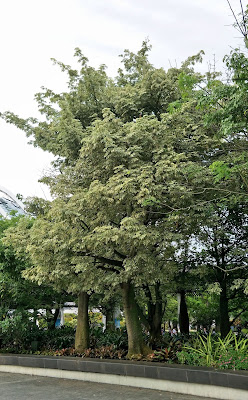Dendro the detective decided to visit a friend who was managing a rather tropical garden. The friend is an arborist and he planned to climb up a
Ceiba speciosa (Brazilian silk floss tree) to do crown cleaning of some deadwood for aesthetics. The detective looked up the crown with his binoculars and handed it to his friend to have a look too. There were thorns on the branches and upper trunk, but no thorns from ground level to about 12 meters up. If the arborist had anchored his climbing line on one of the thorny branches, it could be disastrous. Thorns seemed to be an adaptive feature in
Ceiba speciosa to deter damage by browsing animals when the trees are in juvenile stage. As the tree gets older, the thorns could weather off. The arborist made a note to himself to take some time to look at the upper scaffold branches with binoculars before deciding to climb or not. In this case, he decided to rent an aerial lift.
Ceiba speciosa (Brazilian silk floss tree)
Silk Floss Sky View. Photo by www.flickr.com/photos/tinyfroglet
Silk Floss Tree. Photo by www.flickr.com/photos/tinyfroglet
Ceiba pentandra (Variegated), Variegated Kapok tree at Gardens by the Bay - The lower trunk on the left seemed to be devoid of thorns but the right still have some thorns.
Same variegated species at Hortpark - thorns still present on lower trunk.
On the upper trunk and branches as well.
Signage of the tree at Hortpark.
Some species of Ceiba in the Flower Dome of Gardens by the Bay.
A non-variegated Ceiba pentandra (Kapok tree) at Gardens by the Bay. Appeared to have no thorns anywhere but some bumps though.
A Ceiba of unknown species with menacing thorns on the lower trunk at Singapore Botanic Gardens. In the vicinity of the dry/cactus garden.










The thorns of the Ceiba family are male flowers. Some specimens have them, while others dont..and genetics doesn't seem to be a factor I'm whether an individual Ceiba tree will grow to have thorns.
ReplyDelete